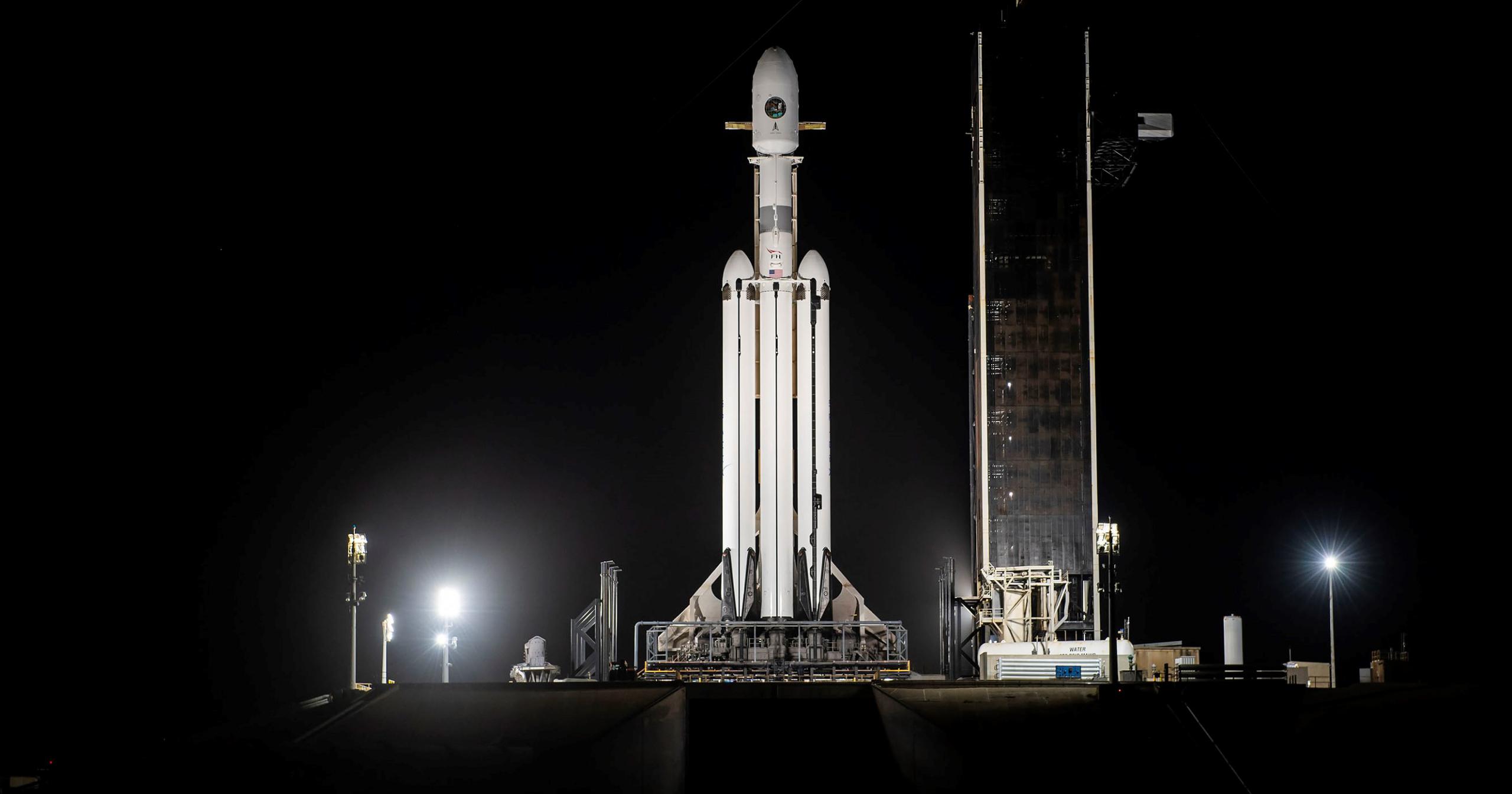

News
SpaceX’s next Falcon Heavy rocket on track for early 2023 launch
Two weeks after SpaceX’s first Falcon Heavy launch in three and a half years, the US Space Force says that the rocket is on track to launch again “early next year.”
Immediately before and after Falcon Heavy’s first operational launch for the US Space Force, the Space Systems Command confirmed that the massive SpaceX rocket’s next military launch – USSF-67 – was scheduled no earlier than January 2023. The military also confirmed that USSF-67 would reuse two of the three Falcon Heavy boosters that helped launch USSF-44 on November 1st.
Two weeks later, the US Space Force’s tone hasn’t changed, and the Space Systems Command remains confident that Falcon Heavy is on track to launch USSF-67 less than three months after USSF-44.
Assuming the lack of a schedule change is intentional rather than a matter of not checking with SpaceX or other US stakeholders, no change is a good sign. Since the last time the SSC reported that USSF-67 was on track to launch in January 2023, SpaceX successfully launched its fourth Falcon Heavy rocket. USSF-44 was the company’s first launch directly into a geosynchronous orbit ~36,000 kilometers (~22,300 mi) above Earth’s surface.
SpaceX successfully recovered both of Falcon Heavy’s ‘side cores’ and has likely had enough time to thoroughly inspect each booster and begin the refurbishment process. If data gathered from the launch, landing, or recovered boosters uncovered issues with Falcon Heavy’s performance during USSF-44, USSF-67 would almost certainly be delayed. The chances of a delay are magnified by the fact that USSF-67 can’t launch until two of USSF-44’s Falcon Heavy boosters are refurbished and declared ready for a second flight.
But it appears that even a gap of 40 months between Falcon Heavy launches wasn’t enough to make SpaceX falter – at least after working out some prelaunch kinks. SpaceX accomplished a similar feat – launching two Falcon Heavy rockets in less than three months with one pair of side boosters – on the rocket’s second and third launches in April and June 2019. The mission that reused Flight 2’s side boosters was for the US Air Force, so SpaceX and the military already have direct experience tackling those challenges.
In the three and a half years since, SpaceX has gained a huge amount of experience recovering and refurbishing Falcon 9 Block 5 boosters and slashed its record turnaround (the time between two launches of the same booster) from 74 days to 21 days. SpaceX should thus have no issue turning Falcon Heavy side boosters B1064 and B1065 around for a second launch in January 2023, around 60 to 91 after their debut.
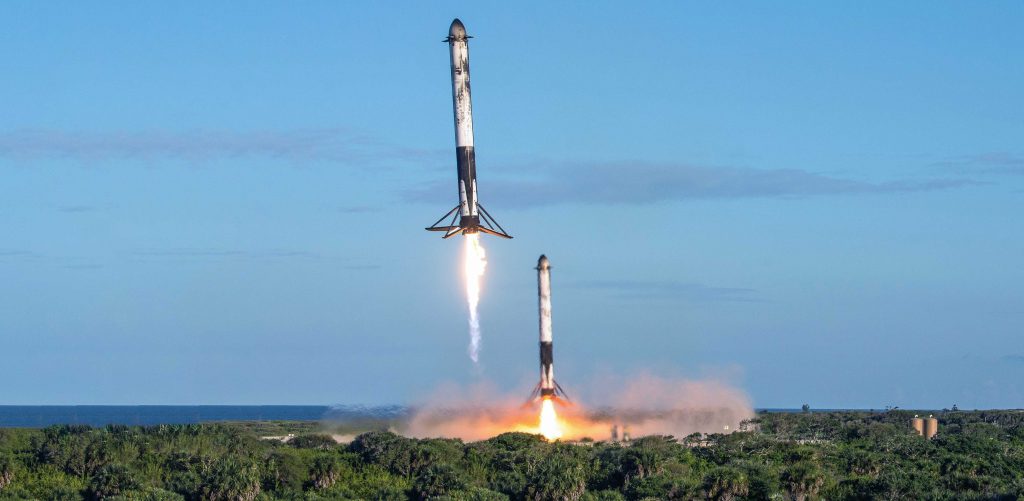
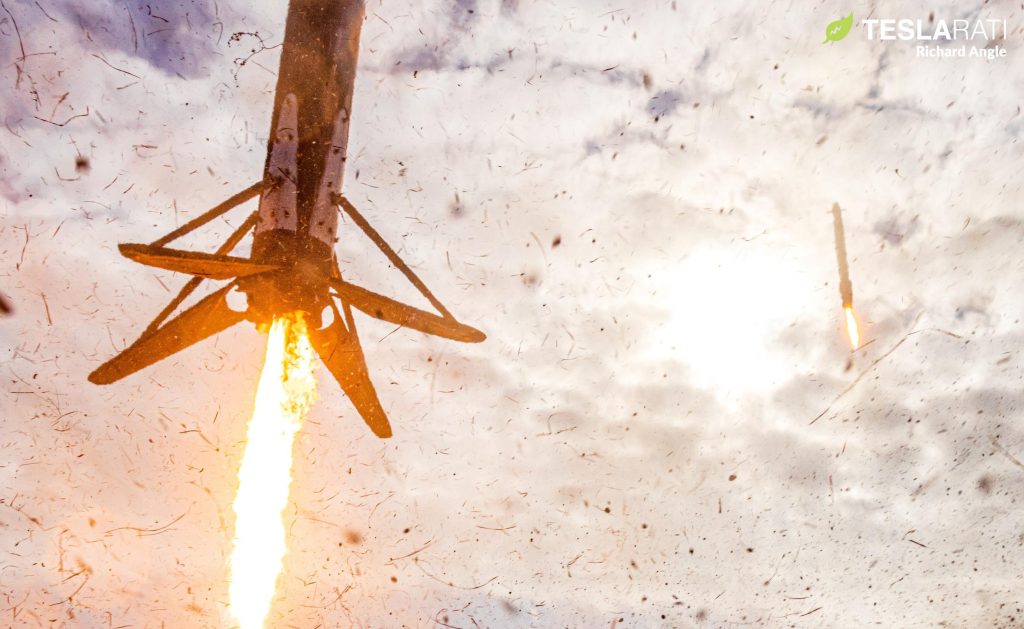
While preparing one Falcon Heavy rocket to launch USSF-67 in January, SpaceX – at least according to customer ViaSat – may also be preparing another Falcon Heavy rocket to launch the first ViaSat-3 satellite the same month. Unlike the US Space Force, which recently shipped [PDF] one of USSF-67’s payloads to Florida, ViaSat has yet to ship its first next-generation satellite to the launch site and says that milestone is scheduled for December 2022. That makes a February or March launch much more likely, but ViaSat recently told shareholders that ViaSat-3 remains on track to launch “in the earliest part of” Q1 2023.
Combined, USSF-67 and ViaSat-3 are scheduled to reuse Falcon Heavy side boosters B1064, B1065, B1052, and B1053. Each will use a brand new center core: B1068 for ViaSat-3 and B1079 for USSF-67, according to Next Spaceflight. Like USSF-44, which was the first time SpaceX intentionally expended a Falcon Heavy booster, both new center cores are expected to be expended.
For several reasons, assembling and preparing Falcon Heavy for launch is significantly more time-consuming than Falcon 9, so there will likely be at least a two, three, or even four-week gap between Falcon Heavy’s next two launches. But as long as USSF-67 and ViaSat-3 are ready to fly during narrow windows in early and late January, it appears that SpaceX could launch two Falcon Heavy rockets in one calendar month.
SpaceX has as many as five Falcon Heavy launches scheduled in 2023 – a stark change after more than three years without a single flight.
News
Tesla Robotaxi has already surpassed Waymo in this key metric
Tesla Robotaxi has already overtaken Waymo in Austin in one key metric, but there’s still more work to do.

Tesla Robotaxi has already surpassed Waymo in one extremely important key metric: size of service area.
Tesla just expanded its service area in Austin on Monday morning, pushing the boundaries of its Robotaxi fleet in an interesting fashion with new capabilities to the north. Yes, we know what it looks like:
🚨 Tesla’s new Robotaxi geofence is…
Finish the sentence 🥸 pic.twitter.com/3bjhMqsRm5
— TESLARATI (@Teslarati) July 14, 2025
The expansion doubled Tesla Robotaxi’s potential travel locations, which now include the University of Texas at Austin, a school with over 53,000 students.
The doubling of the service area by Tesla has already made its travel area larger than Waymo’s, which launched driverless rides in October 2024. It became available to the public in March 2025.
According to Grok, the AI agent on X, Tesla Robotaxi’s current service area spans 42 square miles, which is five square miles larger than Waymo’s service area of 37 square miles.
Tesla Robotaxi (red) vs. Waymo geofence in Austin.
Much can be said about the shape… but the Robotaxi area is now ~3.9 mi² (10 km²) larger than Waymo’s!! pic.twitter.com/dVfh2ODxJC
— Robin (@xdNiBoR) July 14, 2025
The service area is one of the most important metrics in determining how much progress a self-driving ride-hailing service is making. Safety is the priority of any company operating a ride-hailing network, especially ones that are making it a point to use autonomy to deploy it.
However, these companies are essentially racing for a larger piece of the city or cities they are in. Waymo has expanded to several different regions around the United States, including Arizona and Los Angeles.
Tesla is attempting to do the same in the coming months as it has already filed paperwork in both California and Arizona to deploy its Robotaxi fleet in states across the U.S.
As the platform continues to show more prowess and accuracy in its operation, Tesla will begin to expand to new areas, eventually aiming for a global rollout of its self-driving service.
News
Tesla Megapacks arrive for massive battery replacing coal plant
Tesla Megapacks have started arriving on-site to the Stanwell Battery Project, just as Queensland prepares to wind down the Stanwell coal plant.

The first of over 300 Tesla Megapacks have arrived to the site of a massive battery energy storage system (BESS) being built in Australia, dubbed the Stanwell Battery Project after a coal plant it’s set to replace.
In a press release last week, the Stanwell Battery Project announced that the first Tesla Megapack 2XL units had arrived to the site, which is located outside of Rockhampton in Queensland, Australia. The project will eventually feature 324 Megapack units, set to arrive in the coming months, in order to support the 300MW/1,200MWh battery project.
“The Stanwell Battery is part of the diversification of our portfolio, to include cleaner and more flexible energy solutions,” said Angie Zahra, Stanwell Central Generation General Manager. “It is just one part of the 800 MW of battery energy storage capacity we have in our pipeline.
“Capable of discharging 300 MW of energy for up to four hours (1,200 MWh), our mega battery will be one of the largest in Queensland.”
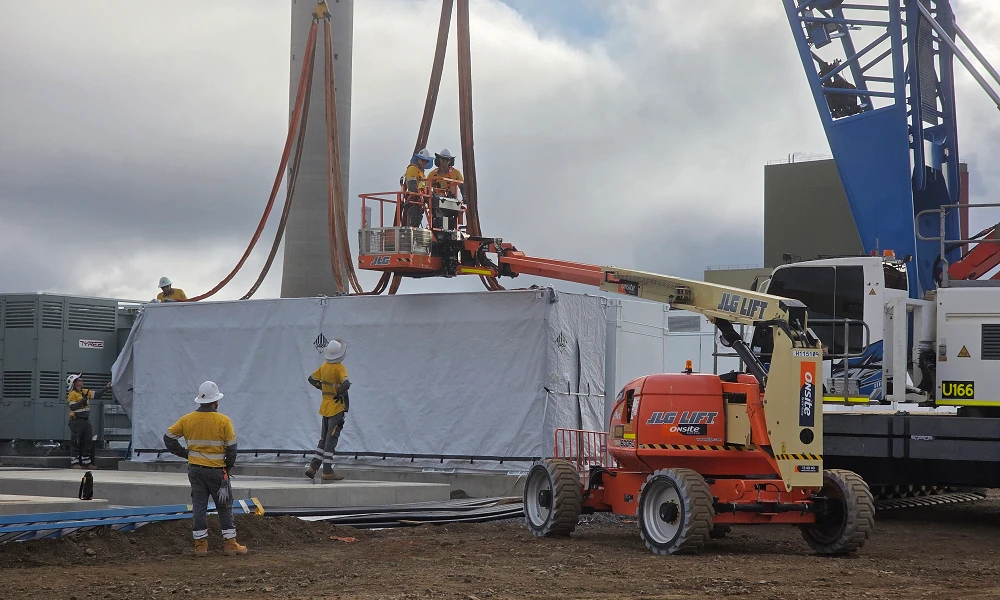
Credit: Stanwell
Did you know Tesla’s Lathrop facility churns out a Megapack every 68 minutes? That’s enough energy to power 3,600 homes for an hour per unit! ⚡️ pic.twitter.com/bG6fpHkB9O
— TESLARATI (@Teslarati) June 11, 2025
READ MORE ON TESLA MEGAPACKS: Tesla Lathrop Megafactory celebrates massive Megapack battery milestone
The state is working with government-owned company Yurika to facilitate construction, and the process is expected to create roughly 80 jobs. The project is expected to come fully online in May 2027, with initial commissioning of the Megapacks aiming for November 2025.
The Stanwell Battery is set to replace the nearby Stanwell coal generation plant, which the government is planning to wind down starting in 2026 as part of efforts to reach an 80 percent renewable energy generation ratio by 2035. Meanwhile, the government is also set to begin winding down the Tarong and Callide coal plants, while several other Megapack projects are being built or coming online. o ya
Tesla currently has two Megapack production facilities, located in Lathrop, California, in the U.S. and another that came online earlier this year in Shanghai, China. The Shanghai Megafactory shipped its first units to Australia in March, while both factories are expected to be capable of producing 10,000 Megapack units per year upon reaching volume production.
News
The Tesla Diner is basically finished—here’s what it looks like
The company first broke ground on the Diner, Drive-in, and Supercharger location in September 2023. Now, it has served one of its first internal customers.

Tesla has finally completed the construction of its highly anticipated Diner, Drive-in, and Supercharger in Los Angeles, and recent photos of the interior’s “retro-futuristic” style are making their way around the internet.
X user Brad Goldberg shared photos from the Tesla Diner site last Tuesday, depicting some of the Supercharger stalls, indoor and outdoor seating areas, multiple neon lights, and even an Optimus robot. Goldberg also noted that there had been a “flurry of activity on site” while he was snapping the photos last week, suggesting that the restaurant location could be getting close to opening.
The Tesla Diner also served one of its first internal customers in the past few days, as Elon Musk posted on X on early Monday morning that he had just finished up eating a meal at the site:
I just had dinner at the retro-futuristic Tesla diner and Supercharger.
Team did great work making it one of the coolest spots in LA!
The photos also show that the site is pretty much done, with some of them even showing vehicles charging at the charging stalls.
You can see some of the latest photos of the Tesla Diner below.
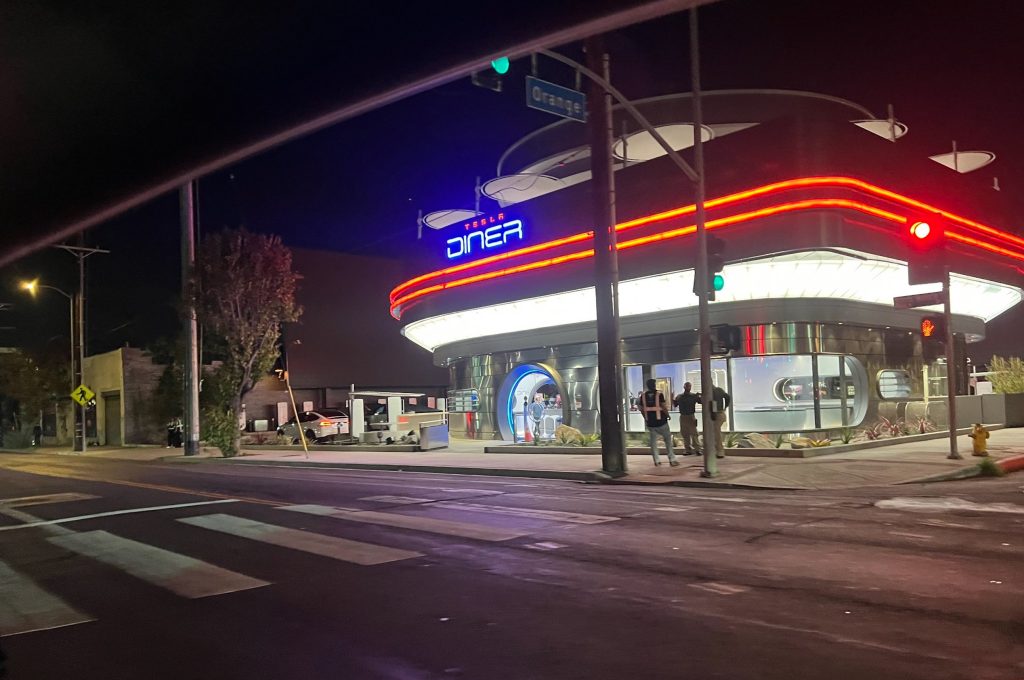
Credit: BradGoldbergMD | X

Credit: BradGoldbergMD | X

Credit: BradGoldbergMD | X

Credit: BradGoldbergMD | X

Credit: TeslaKing420 | X

Credit: TeslaKing420 | X

Credit: Brad Goldberg (via Sawyer Merritt on X)

Credit: Brad Goldberg (via Sawyer Merritt on X)

Credit: Brad Goldberg (via Sawyer Merritt on X)

Credit: Brad Goldberg (via Sawyer Merritt on X)

Credit: Brad Goldberg (via Sawyer Merritt on X)
READ MORE ON TESLA’S LA DINER: Tesla readies Drive-In Diner Supercharger for launch with app inclusion
When will the Tesla Diner open to external customers?
While it’s still not open to external customers yet, the news again suggests that the company could be close to an official opening date. Tesla first broke ground on the Diner in September 2023, after receiving a wave of building permit approvals throughout that year. Teslarati also covered much of the construction progress throughout last year, including when crews installed the first and second drive-in screens.
Located at 7001 West Santa Monica Boulevard, the idea was first discussed in 2018 by Musk and a few others on Twitter, featuring 1950s rock and roll, waiters on roller skates, and drive-in movie theater screens playing clips from some of history’s best movies. Notably, the photos of the front doors also show that the site will be open 24 hours a day, 7 days a week, whenever it does end up opening.
Tesla’s progress on Supercharger with diner, drive-in seen in aerial footage
-

 Elon Musk2 weeks ago
Elon Musk2 weeks agoTesla investors will be shocked by Jim Cramer’s latest assessment
-

 News2 days ago
News2 days agoTesla debuts hands-free Grok AI with update 2025.26: What you need to know
-

 Elon Musk4 days ago
Elon Musk4 days agoxAI launches Grok 4 with new $300/month SuperGrok Heavy subscription
-

 Elon Musk6 days ago
Elon Musk6 days agoElon Musk confirms Grok 4 launch on July 9 with livestream event
-

 News1 week ago
News1 week agoTesla Model 3 ranks as the safest new car in Europe for 2025, per Euro NCAP tests
-

 Elon Musk2 weeks ago
Elon Musk2 weeks agoxAI’s Memphis data center receives air permit despite community criticism
-

 News4 days ago
News4 days agoTesla begins Robotaxi certification push in Arizona: report
-

 Elon Musk2 weeks ago
Elon Musk2 weeks agoTesla scrambles after Musk sidekick exit, CEO takes over sales

















